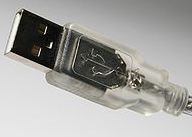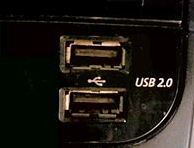USB
 |
||
 |
There is four different versions of USB ports
- Version 1.0 - obsolete and most systems do not use
- Version 1.1 - most older systems and devices use this version
- Version 2.0 - New systems and devices se this version (Didn't come out till 2001)
- Version 3.0 - Majority of systems have this version or version 3.1. 3.0 can transfer data up to 5 Gbit/s (625 MB/s)
- Version 3.1 - Latest version Seep to 10Gbps.
The devices are hot swappable. This means you can plug the device
in while you are in windows. This will not corrupt the windows or
damage the system. Other connections can harm the system or corrupt
windows if you plug it in while in windows. The connections that
will harm the system is parallel cables, PS2 cables, monitor cables,
speaker cables and other non USB cables. To connect non USB cables
require you to turn the system off first and then connect the
cables.
To disconnect a USB cable, you have to stop the service. To stop the
service, click on the icon for hardware removal by the clock and
choose the device you want to stop. Then it will give you a message
that it is safe to remove.
Another advantage of USB is that you can plug the USB device into
any USB port. If there is four ports, you can plug it into any of
the four ports.
USB allows up to 127 USB devices to be plugged in. However, each
device uses power and resources of the system. Each system has
different specifications and unable to list the number of devices
each system will handle because of it.
There is two types of USB
- Self powered - They pull their power from the computer
- Non powered - requires a wall outlet to get their power (best option)
I do not recommend the self powered USB devices. The more devices
that is connected to a computer using the power supply for devices,
the less power each device has available. A self powered may not
work all the time because of the power requirement. The power supply
may not be able to provide the required amount of power to run the
device.
Most systems come with 2 to 4 USB ports. If you need more ports, you
can use a USB hub to add ports. You can also daisy chain hubs (connect
a USB hub to another hub and that hub connects to the computer)
to have additional ports.
- USB connections - Info on the connections
- USB driveletter - Info on USB drive letters
- USB Flashdrives - How to use a flash drive
- USB Boot hangs - BIOS is set to boot to USB
- USB Hubs - Info on USB Hubs
- USB safe mode - Info on accessing USB in safe mode
- USB upgrade - info on upgrading USB
- USB version - How to determine if the speed of port
